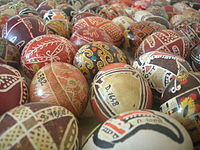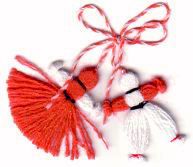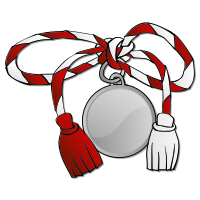Folklore of Romania: Difference between revisions
Danielsavoiu (talk | contribs) |
Danielsavoiu (talk | contribs) +references section |
||
| Line 185: | Line 185: | ||
*[[Oaş Dance]] |
*[[Oaş Dance]] |
||
*[[Sârba Sita Buzălilui]] |
*[[Sârba Sita Buzălilui]] |
||
== References == |
|||
<references /> |
|||
{{Romanian topics}} |
{{Romanian topics}} |
||
| Line 190: | Line 193: | ||
[[Category:Romanian folklore]] |
[[Category:Romanian folklore]] |
||
[[Category:Romanian culture]] |
[[Category:Romanian culture]] |
||
['''Romanian VIP Magazine'''] [www.romanianvip.com] is an interesting reference for who wants to learn about Romania, Romanians, their language, history and culture. Use Google Translation Romanian- English in order to read it. |
|||
[[ro:Folclorul românesc]] |
[[ro:Folclorul românesc]] |
||
Revision as of 12:38, 15 August 2008
| Part of a series on the |
| Culture of Romania |
|---|
 |
| People |
| Languages |
| Sport |

A feature of Romanian culture is the special relationship between folklore and the learned culture, determined by two factors. First, the rural character of the Romanian communities resulted in an exceptionally vital and creative traditional culture. Folk creations (the best known is the ballad Mioriţa) were the main literary genre until the 18th century. They were both a source of inspiration for cultivated creators and a structural model. Second, for a long time learned culture was governed by official and social commands and developed around courts of princes and boyars, as well as in monasteries.
Characteristics
Strong folk traditions have survived to this day due to the rural character of the Romanian communities, which has resulted in an exceptionally vital and creative traditional culture. Romania's rich folk traditions have been nourished by many sources, some of which predate the Roman occupation. Traditional folk arts include wood carving, ceramics, weaving and embroidery of costumes, household decorations, dance, and richly varied folk music. Ethnographers have tried to collect in the last two centuries as many elements as possible: the Museum of the Romanian Peasant and the Romanian Academy are currently the main institutions which systematically organise the data and continue the research.
Wood used to be the main construction material, and heavily ornamented wooden objects were common in old houses. In Maramureş wood was used to create impressive structures such as churches or gates, in Dobruja windmills were made of wood, and in mountainous regions hardwood was used even for covering the roof. To preserve traditional houses many village museums have been created in the last century throughout Romania, such as the Village Museum in Bucharest, the Traditional Popular Civilisation ASTRA Museum in Sibiu or the Oltenian Village Museum in Râmnicu Vâlcea.
Linen was the most common material for clothing, combined with wool during the winter or colder periods. These are embroidered with traditional motifs that vary from region to region. Black is the most common colour used, but red and blue are predominant in certain areas. Traditionally, men wore a white shirt and pants (if made of wool they are called iţari) with wide a leather belt, usually over the shirt, and a vest sometimes made of leather and embroidered. They wore either boots or a simple shoe made of leather and tied around the foot called opincă and they wore a hat which differs in design from region to region. Women also wore a white skirt and a shirt with a vest. They wore an apron called şorţ or cătrinţă which is also embroidered and a headscarf called basma;on special occasions they wore more elaborate outfits.
Music and dance represent a lively part of the Romanian folklore and there are a great variety of musical genres and dances. Party music is very lively and shows both Balkan and Hungarian influences. Sentimental music, however, is the most valued, and Romanians consider their doina (a sad song either about one's home or about love, composed like an epic ballad) unique in the world. Maria Tănase is considered to be one of the greatest Romanian folk singers and today Grigore Leşe and Taraful Haiducilor are two of the most famous musicians. The dances are lively and are practiced throughout Romania by a large number of professional and amateur groups, thus keeping the tradition alive; Hora is one of the most famous group dances but men's folk dances such as căluşari are extremely complex and have been declared by UNESCO to be "Masterpieces of the Oral and Intangible Heritages of Humanity".
Romanians have had, from time immemorial, a myriad of customs, tales and poems about love, faith, kings, princesses, and witches. Ethnologists, poets, writers and historians have tried in recent centuries to collect and to preserve tales, poems, ballads and have tried to describe as well as possible the customs and habits related to different events and times of year. Customs related to certain times of year are the colinde - Romanian Christmas carols, sorcova on New Year's Eve or the Mărţişor custom on the 1st of March marking the spring. Other customs are presumably of pre-Christian pagan origin, like the Paparuda rain enchanting custom in the summer, or the masked folk theatre or Ursul (the bear) and Capra (the goat) in winter.
Perhaps the most successful collector of folk tales was the novelist and storyteller Ion Creangă, who, in very picturesque language, shaped into their now-classic form stories like Harap Alb (roughly, "The White Prince") or Fata babei şi fata moşului (roughly, "The old woman's girl and the old man's girl"). Also, the poet Vasile Alecsandri published the most successful version of the ballad Mioriţa (The Little Ewe), a sad, philosophical poem, centered around a simple action: the plot by two shepherds to kill a third shepherd because they envied his wealth. Another prolific editor of folk tales was Petre Ispirescu, who, in the 19th century published an impressive number of volumes containing a large number of short novels and tales from popular mythology. They are centered around popular characters like the prince Făt-Frumos (the Romanian "Prince Charming"), the princess Ileana Cosânzeana, the villain or monster Zmeu or Căpcăun, the dragon Balaur or fantastic superbeings like the good Zână and the evil Muma Pădurii.

Cosmogony
The creation of the world in Romanian folklore is most probably based on mazdeist doctrines, which entered the mythologies of many peoples including the Daci, the ancestors of the Romanian people, and which were left behind by these. As such, far from coinciding with the story in the Book of Genesis, cosmogony is largely dualist in nature, depicting the Earth as the common opus of God and the Devil, imagined as counterparts of Ahura Mazda and Angra Mainyu rather than in the biblical way. However, different stories suggest God made the earth with the help of animals, while Satan was trying to thwart his plans.[1]
In the majority of versions, before the earth existed, a boundless ocean called Apa Sâmbetei was the abode of God and the Devil, seen as master and servant rather than equals. Upon deciding to create the earth, God sent the Devil to bring a handful of clay from the ground of the World Ocean in his holy name. The Devil set forth and tried to bring it to the surface in his name instead, but could not succeed until he brought it up in the name of God. As this piece of clay grew into the earth, God laid himself down to sleep. The Devil tried to push him over the side, but the ever expanding earth would hinder that. After trying to throw God off the earth in every one of the four cardinal directions, he shied away from the cross he drew in the ground himself.[2]
Other accounts, closer to the biblical one, suggest that the Devil and his demons were once angels of God. The Devil, however, tried to rebel, and, in response, God opened up the Heavens so that he might fall to the earth. Fearing that Heaven might be voided, the archangel Michael re-sealed it, thus freezing the demons that had not yet fallen to hell in place. This is related to the concept of soul customs, where every soul is intercepted on its way to Heaven by these demons, who force it into hell. It has also given rise to the Romanian saying până ajungi la Dumnezeu, te mănâncă sfinţii (before you reach God, the saints will eat you).[3]
Another question commonly addressed is that of the origin of God, which is explained in a Russian doll type fashion. Before every God there was another God that created him. Thus explaining the many names the Bible used for God, the Oltenians believed the first God was called Sabaoth, followed by Amon, Apollo, the Creator God of the Bible, and finally, Jesus Christ.[4]
Places
- Apa Sâmbetei
- Apa Vie/Apa Moartă
- Sorbul Pǎmântului
Folk tales
- Mioriţa
- Meşterul Manole (Manole the Craftsman)
Romanian myths part of international culture
- Vampire - See strigoi and moroi, which are more phantom- or wizard-like creatures.
- Werewolf (Vârcolac)
- Şobolan - A giant rat similar to the SA capybara. Rural Romanian folklore attributes the şobolan human characteristics.
- Solomonar - See Hultan and Solomonari, which were a group of nobles and wizards made famous more by the families who were members of the society then for their deeds. However, this is mainly do to the secret crusades of Christianity and their attempt to destroy all history and knowledge of these Wizards. Some of these names include Dracula Vlad, Solomon, Despina the Impure, Ty'ere, Ventruszch, Brohmyr, Izhain and Vohc.
Most of these names can be found in Romanian Lore in reference to Vampires and Dragons.
Rituals
Fairy tales
- "The Boys with the Golden Stars"
- "The 12 Sisters and the Demon Bride"
- "Seventh son of a Seventh son"
- "Let thee be marked in magic"
Personages in folk literature
- Baba Dochia
- Balaur (a type of dragon)
- Baubau, variant form Babau (similar to the Bogeyman)
- Căpcăun (an ogre)
- Căţelul Pământului
- Fata Pădurii
- Ileana Cosânzeana
- Iele
- Luceafăr - similar to Lucifer
- Moroi (a type of vampire)
- Moşul (the old man)
- Muma Pădurii
- Pricolici (a werewolf or demon)
- Rohmani (or Blajini)
- Samca
- Solomonari
- Sânziana (or Drăgaică)
- Spiriduş (a sprite)
- Stafie - similar to Ghost
- Strigoi (a vampire or zombie)
- Uniilă (a devil )
- Uriaş - similar to Giant
- Ursitoare - similar to the Fates
- Vasilisc - similar to Basilisk
- Vâlva
- Vântoase (spirits of the wind)
- Vârcolac (werewolf or goblin)
- Zână (fairy)
- Zburător
- Zorilă
- Zmeu
Heroes
- Ber-Căciulă
- Doamna Neaga
- Făt-Frumos
- Ileana Cosânzeana
- Greuceanu
- Iovan Iorgovan
- Ler Imparat
- Luana
- Baba Novac
List of folk dances
- Bătute
- Brâul, Sash dance
- Buciumeana, hornpipe dance
- Căluşari (Călus, Căluşul)
- Ciuleandra
- Hora a circle dance
- Geamparale
- Joc
- Joc cu bâta (Jocul cu bâta), Joc with stick
- Mărunţel
- Periniţa, translated as "Little pillow", a dance of wedding traditions, a.k.a. Handkerchief Joc
- Pe loc, "On Spot", a stomping dance
- Poarga românescă (Romanian polka)
- Sârba
- Tropotiţe
Banat plain
- Sorocul de la Beregsaul Mare
- Sorocul de la Jebel
- Pe loc ca la Murava
- Pe loc a lui lefta Lupu
- Intoarsa
Banat mountain
- Briu Batrin
- Ardeleana de la Rugi
- Ardeleana Baba Peleaga
- Ardeleana ca pe Valea Almajului
- Doiul roata de la Glimboca
- De doi ca la Caransebes
Moldavia
- Băiţenească
- Bătrânesca din Bucovina
- Arcanul
- Arcanul Bătrânesc
- Bătuta
- Hora Câmpulungului
- Hora de la Munte
- Raţa
- Hora miresei
- Batuta de la Tudora
- Batuta de la Vorona
Oltenia
- Alunelul de la Goicea
- Sârba Căluşerească
- Sârba Oltenească
- Trei Păzeşte de la Bistreţ
- Trei Păzeşte de la Dolj
- Bobocica
- Boiereasca
- Alunelul
- Briuletul
- Hora mare
- Galaonul
Bihor
Nasaud
- De-a lungul
- Barbuncul
- Invirtita



